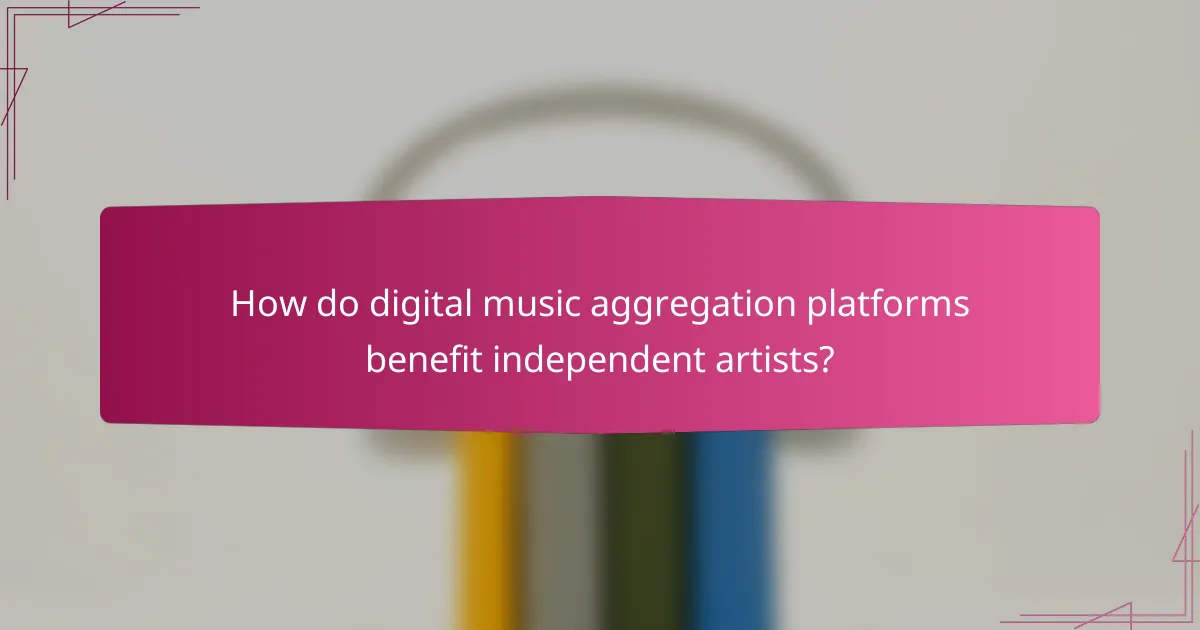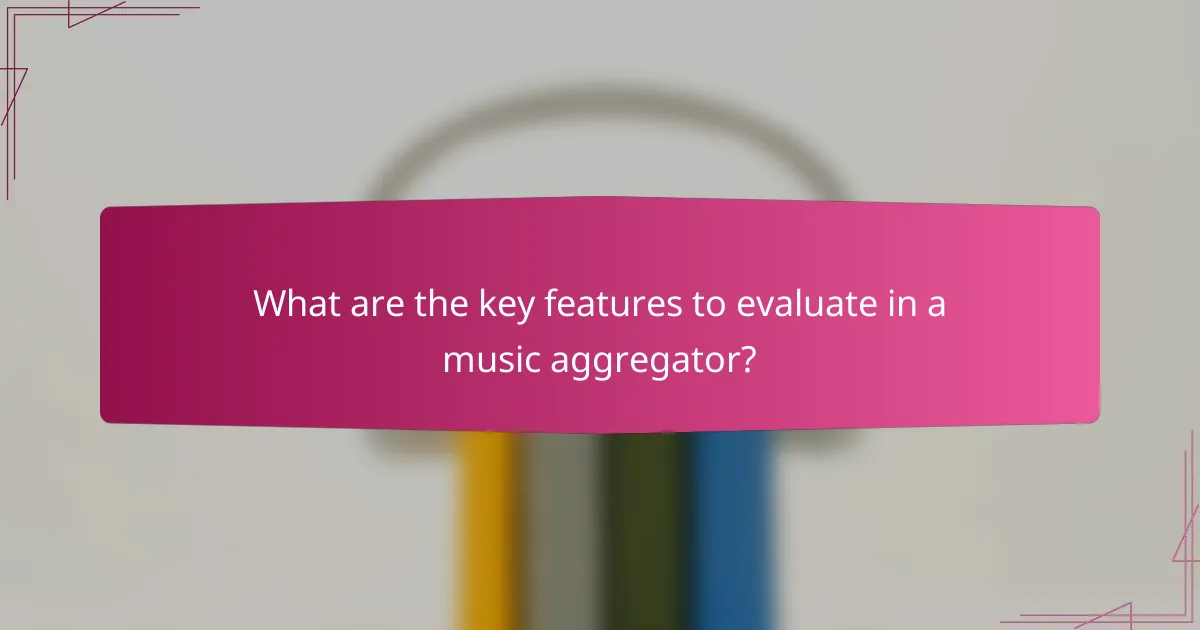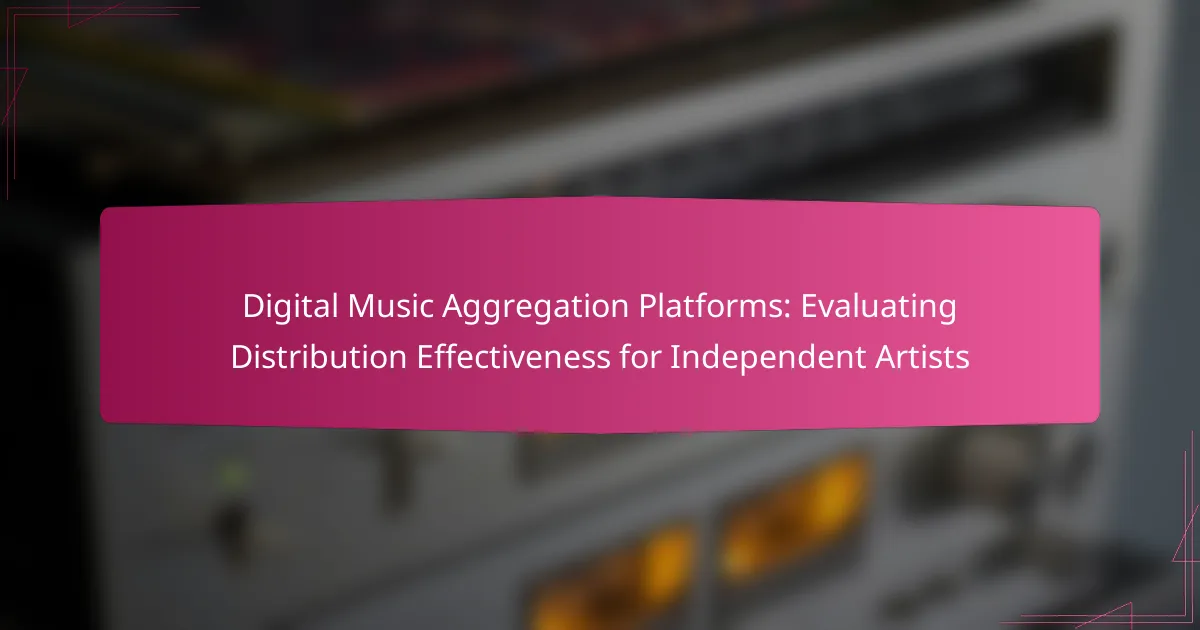Digital music aggregation platforms are vital for independent artists seeking to distribute their music effectively and enhance their revenue streams. By simplifying the process of reaching major streaming services, these platforms enable artists to concentrate on their creativity while expanding their audience. However, the effectiveness of these services can differ significantly, making it crucial for artists to assess their specific needs and the features offered by each platform.

How do digital music aggregation platforms benefit independent artists?
Digital music aggregation platforms provide independent artists with essential tools to distribute their music widely, increase revenue, and gain valuable insights. These platforms streamline the process of getting music onto major streaming services, allowing artists to focus on their craft while maximizing their reach and earnings.
Wider distribution channels
Digital music aggregation platforms enable independent artists to distribute their music across multiple channels, including popular streaming services like Spotify, Apple Music, and Amazon Music. By using these platforms, artists can reach global audiences without the need for traditional record labels.
Many aggregators offer distribution to dozens, if not hundreds, of platforms, which significantly expands an artist’s potential listener base. This broad reach is crucial for independent artists looking to establish a presence in the competitive music industry.
Increased revenue opportunities
Independent artists can tap into various revenue streams through digital music aggregation platforms. These include streaming royalties, digital downloads, and even sync licensing opportunities for film and television.
By distributing their music widely, artists can increase their chances of earning revenue from different sources. It’s essential to choose an aggregator that offers competitive rates and transparent royalty structures to maximize earnings.
Access to analytics and insights
Aggregation platforms provide artists with access to detailed analytics and insights about their music’s performance. This data includes listener demographics, streaming numbers, and geographic locations, which can inform marketing strategies and future releases.
Understanding audience behavior allows artists to tailor their promotional efforts and engage more effectively with their fan base. Regularly reviewing these analytics can help artists identify trends and adjust their strategies accordingly.
Enhanced marketing support
Many digital music aggregation platforms offer marketing tools and resources to help independent artists promote their music. This can include playlist placements, social media promotion, and email marketing campaigns.
Utilizing these marketing features can significantly boost an artist’s visibility and engagement. Artists should take advantage of any promotional opportunities provided by their aggregator to maximize their reach.
Streamlined royalty collection
Digital music aggregation platforms simplify the royalty collection process for independent artists. They handle the complex task of collecting and distributing royalties from various sources, ensuring that artists receive their earnings efficiently.
By using a reliable aggregator, artists can avoid the hassle of managing multiple payment systems and focus on their music. It’s crucial to choose a platform known for timely and accurate royalty payments to ensure financial stability.

Which digital music aggregation platforms are most effective?
The effectiveness of digital music aggregation platforms varies based on features, pricing, and distribution reach. Independent artists should consider their specific needs, such as budget and desired services, when choosing a platform.
DistroKid
DistroKid is known for its straightforward pricing model, allowing artists to upload unlimited music for a flat annual fee. This platform distributes to major streaming services like Spotify and Apple Music, making it a popular choice for those looking to maximize their reach without incurring per-release fees.
One key advantage is the speed of distribution, often taking just a few days. However, artists should be aware that DistroKid takes a percentage of royalties from cover songs, which can impact earnings.
TuneCore
TuneCore operates on a pay-per-release basis, charging fees for each single or album uploaded. This model can be beneficial for artists who release music infrequently, as they only pay when they need to distribute new content.
With a broad distribution network, TuneCore ensures music reaches various platforms, but artists should consider the cumulative costs over time, especially if they release music regularly. They also offer additional services like publishing administration for an extra fee.
CD Baby
CD Baby combines a one-time fee for distribution with options for physical CD sales, making it a versatile choice for artists. They distribute to numerous platforms and also provide services like sync licensing, which can open additional revenue streams.
Artists should note that CD Baby takes a percentage of royalties, which can vary based on the services selected. This platform is particularly suitable for those who want a mix of digital and physical distribution.
Amuse
Amuse offers a unique model with a free tier that allows artists to distribute music without upfront costs. They also provide a Pro version with additional features for a monthly fee, appealing to those who want to scale their distribution as they grow.
The free option has limitations on the number of releases per year, so artists should evaluate their output. Amuse is a good choice for emerging artists looking to test the waters without financial commitment.
LANDR
LANDR is primarily known for its automated mastering services, but it also offers music distribution. Artists can benefit from high-quality mastering alongside their distribution needs, making it a one-stop shop for music production.
However, LANDR’s distribution service may not be as extensive as others, so artists should check if their target platforms are included. This platform is ideal for those who prioritize sound quality and want to streamline their music creation process.

What are the key features to evaluate in a music aggregator?
When evaluating a music aggregator, focus on features that directly impact distribution effectiveness, such as reach, pricing, royalty rates, support, and additional services. These elements will help independent artists maximize their exposure and revenue.
Distribution reach
Distribution reach refers to the number of platforms and territories where your music can be made available. A good aggregator should connect to major streaming services like Spotify, Apple Music, and Amazon Music, as well as smaller, niche platforms that cater to specific audiences.
Consider whether the aggregator offers global distribution or is limited to certain regions. For independent artists, a wider reach can lead to increased visibility and potential revenue streams.
Pricing structure
The pricing structure of a music aggregator can vary significantly, typically involving either a flat fee, a percentage of sales, or a combination of both. Flat fees may be more predictable, while percentage-based models can be more cost-effective for artists with lower sales volumes.
Look for any hidden fees, such as annual renewal costs or charges for additional services. Understanding the pricing model will help you budget effectively and avoid unexpected expenses.
Royalty payout rates
Royalty payout rates determine how much you earn from your music sales and streams. Different aggregators offer varying rates, often ranging from 70% to 90% of the revenue generated.
Evaluate the payout frequency as well; some platforms pay monthly while others may have longer cycles. Higher payout rates and more frequent payments can significantly impact your overall earnings.
Customer support options
Effective customer support is crucial for resolving issues quickly. Look for aggregators that provide multiple support channels, such as email, live chat, and phone support.
Check for user reviews regarding the responsiveness and helpfulness of the support team. Good customer service can save you time and frustration, especially when dealing with distribution problems.
Additional services offered
Many music aggregators provide additional services that can enhance your distribution experience. These may include promotional tools, analytics, and marketing support to help you grow your audience.
Consider whether the aggregator offers services like playlist pitching, social media promotion, or mastering. These extras can provide valuable assistance in building your brand and increasing your music’s reach.

How do pricing models vary among digital music aggregators?
Pricing models for digital music aggregators can differ significantly, impacting how independent artists distribute their music. Understanding these variations helps artists choose the right platform based on their budget and distribution needs.
Flat fee vs. percentage-based
Flat fee models charge a set amount for distribution, regardless of sales. This can be beneficial for artists expecting high sales, as they retain more revenue after the initial fee is paid.
In contrast, percentage-based models take a portion of the revenue generated from sales or streams. While this may seem lower upfront, it can add up over time, especially for artists with fluctuating income.
Annual subscription costs
Some aggregators require an annual subscription fee, which can range from low tens to several hundred dollars. This model often includes additional services like analytics and marketing tools.
Artists should weigh the benefits of these services against the cost. If the tools provided can help increase visibility and sales, the subscription may be worth the investment.
Per-release fees
Per-release fees charge artists each time they release new music. This model can be advantageous for those who release infrequently, as it avoids ongoing costs.
However, for artists planning multiple releases in a year, these fees can accumulate quickly. It’s essential to calculate potential costs based on release schedules to avoid surprises.
Free vs. paid tiers
Many aggregators offer free tiers with limited features, allowing artists to distribute music without upfront costs. However, these options often come with restrictions, such as fewer distribution channels or lower royalty rates.
Paid tiers typically provide more comprehensive services, including better support and wider distribution. Artists should assess whether the additional features justify the cost based on their career goals and expected revenue.

What are the common challenges faced by independent artists in music distribution?
Independent artists often encounter several challenges in music distribution, including limited access to major platforms, financial constraints, and the complexities of marketing their music effectively. These hurdles can hinder their ability to reach wider audiences and generate revenue.
Limited Access to Major Platforms
Many independent artists struggle to get their music onto popular streaming platforms like Spotify or Apple Music due to stringent requirements and competition from established artists. Distribution services may prioritize signed artists or those with existing fan bases, making it harder for newcomers to gain visibility.
To overcome this, independent musicians should consider using digital music aggregators that cater specifically to unsigned artists. These platforms often provide a more accessible route to distribution, allowing artists to upload their music without needing a record label.
Financial Constraints
Budget limitations can significantly impact an independent artist’s ability to distribute their music effectively. Costs associated with production, marketing, and distribution can quickly add up, leaving little room for promotional efforts.
Artists should explore cost-effective distribution options, such as platforms that charge a flat fee or take a small percentage of earnings. Additionally, leveraging social media and DIY marketing strategies can help minimize expenses while maximizing reach.
Complexities of Marketing
Marketing music as an independent artist can be daunting due to the vast number of competing releases and the need for a strong online presence. Many artists lack the expertise or resources to effectively promote their work, which can lead to underwhelming sales and streaming numbers.
To enhance their marketing efforts, artists should focus on building a personal brand and engaging with their audience through social media. Creating compelling content, such as behind-the-scenes videos or interactive posts, can foster a loyal fan base and increase visibility in a crowded market.
